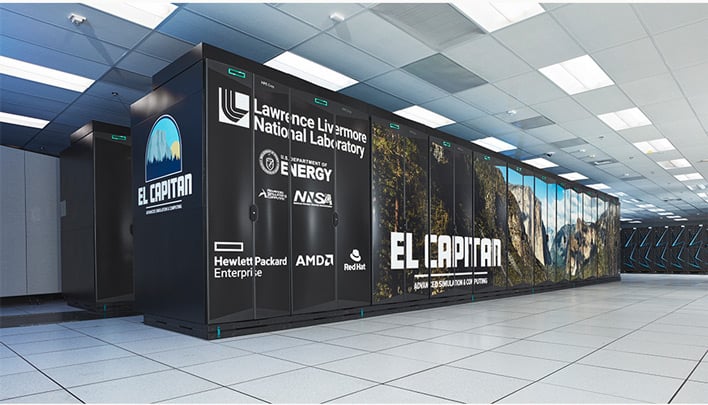AMD-Powered El Capitan Supercomputer Rips 17.41 PetaFLOPS To Stay #1 Globally
Since we're computer geeks here, we'll go straight to the juicy specs. The machine was built by HP Enterprise (HPE) and is based on a Cray EX Shasta architecture (bet you hadn't heard that name in a while). It comprises 11,136 nodes, and each node contains four compute units. Each of these units contains 128 GB of ultra-wide HBM3 memory, a 24-core AMD EPYC Genoa processor, and an AMD Instinct MI300A APU.
Doing the math on the entire deal works out to 11 million CPU cores, 43,808 Instinct accelerators, and 5.4375 petabytes of RAM. The nodes talk to each other via HPE Slingshot switches in a dragonfly topology. Surprisingly, the whole super computer takes up just 700 m2 (two tennis courts), or 7,535 sq ft, spread across 87 racks.

What this works out to is that El Capitan can run the High-Performance Linpack benchmark at 1.742 exaFLOPS. That's an "exa" prefix right there, meaning quintillions of operations per second. It's a figure that's hard to grasp, as is the 17.41 petaFLOPS the machine can reach with the High-Performance Conjugate Gradient test. This latter software is quite memory-intensive and apparently a good analog to common scientific and engineering use cases. To wrap it up, El Capitan posted a score of 16.7 exaFLOPS in the mixed-precision HPL-MxP AI benchmark.
The machine belongs to the U.S. Department of Energy, who also owns Frontier and Aurora, the #2 and #3 computers in the TOP500 ranking. These machines are the only ones in the list whose speed is measured in the exaFLOP range. Reports of whether these machines can run Crysis are yet to come.

